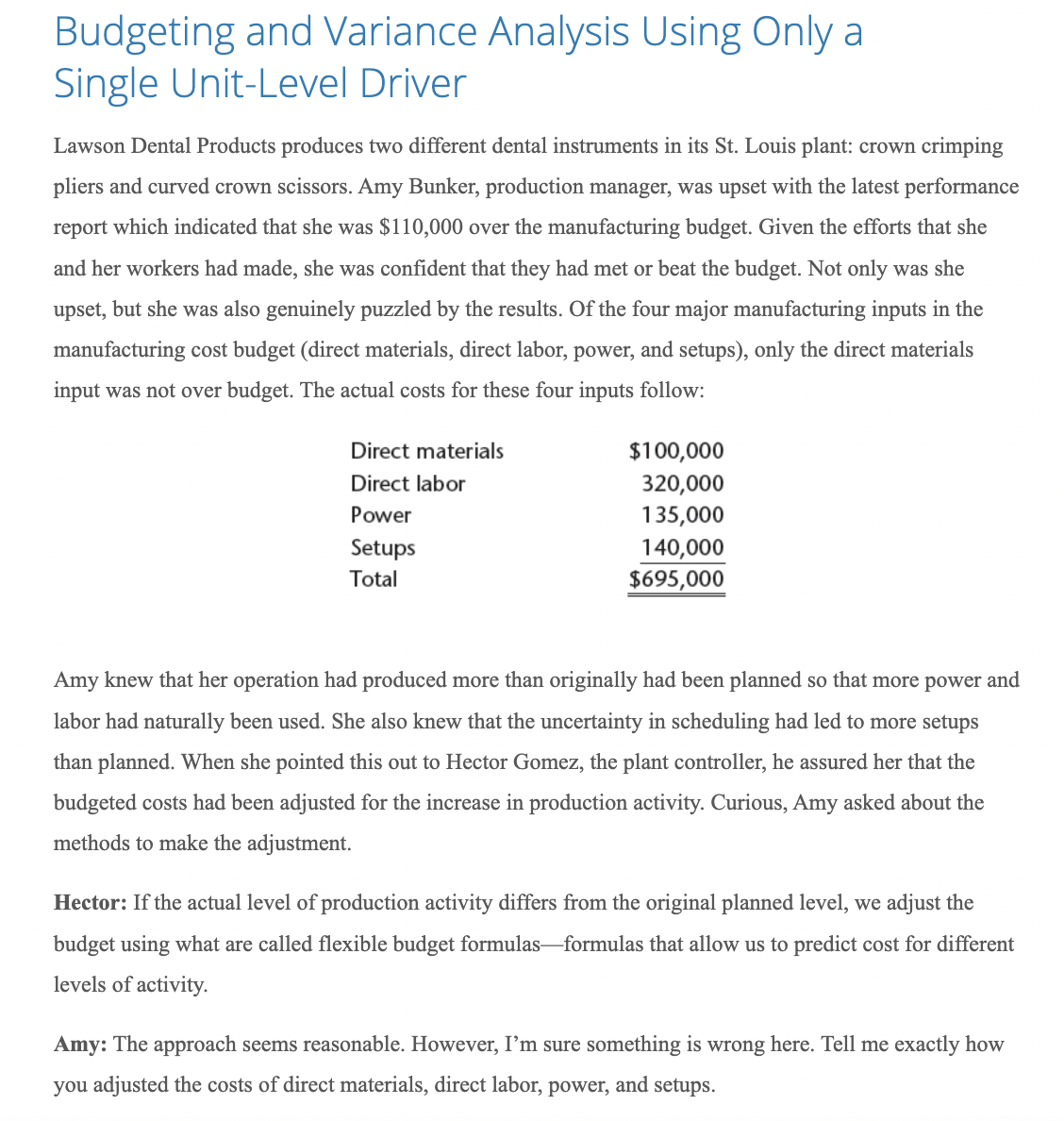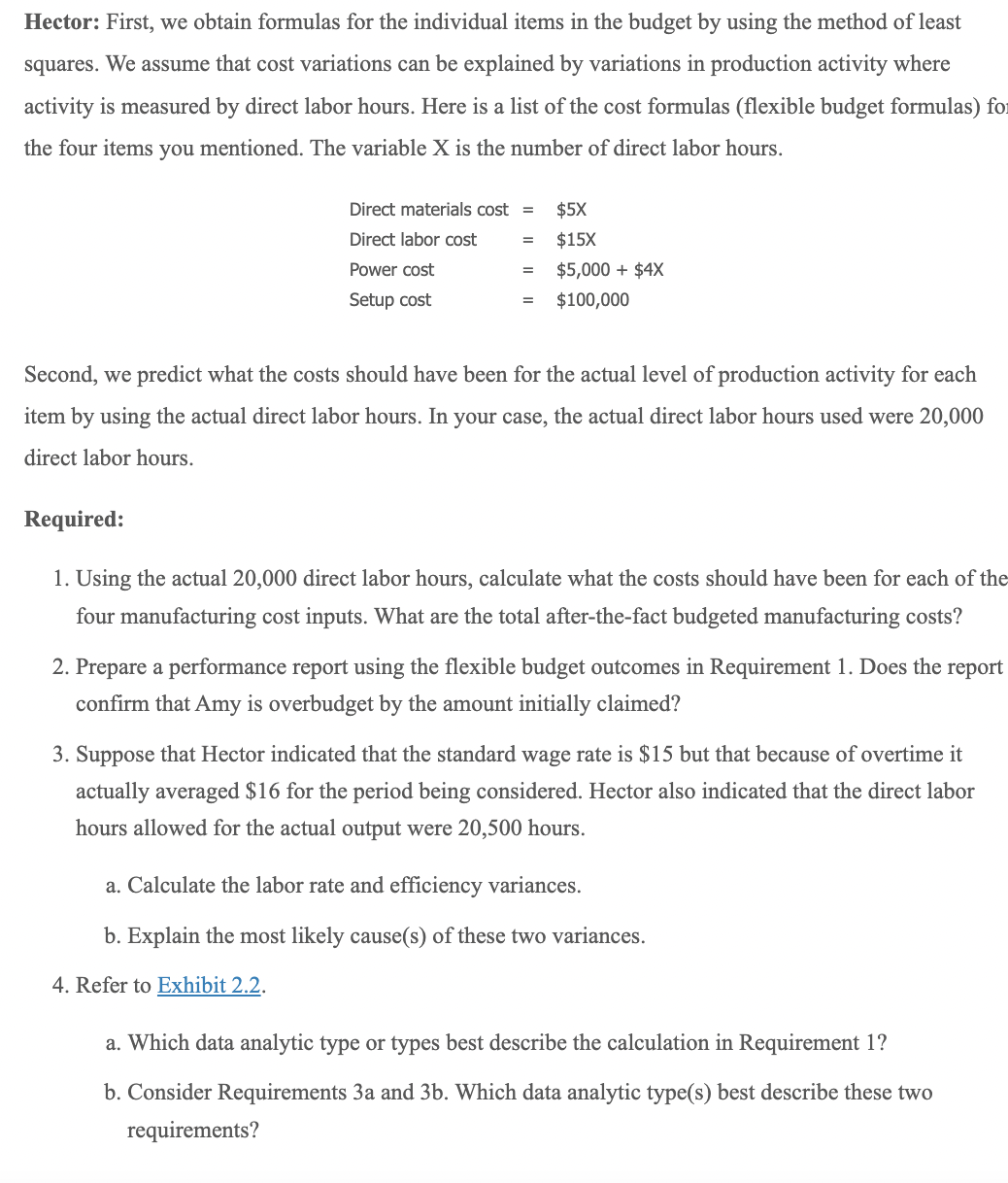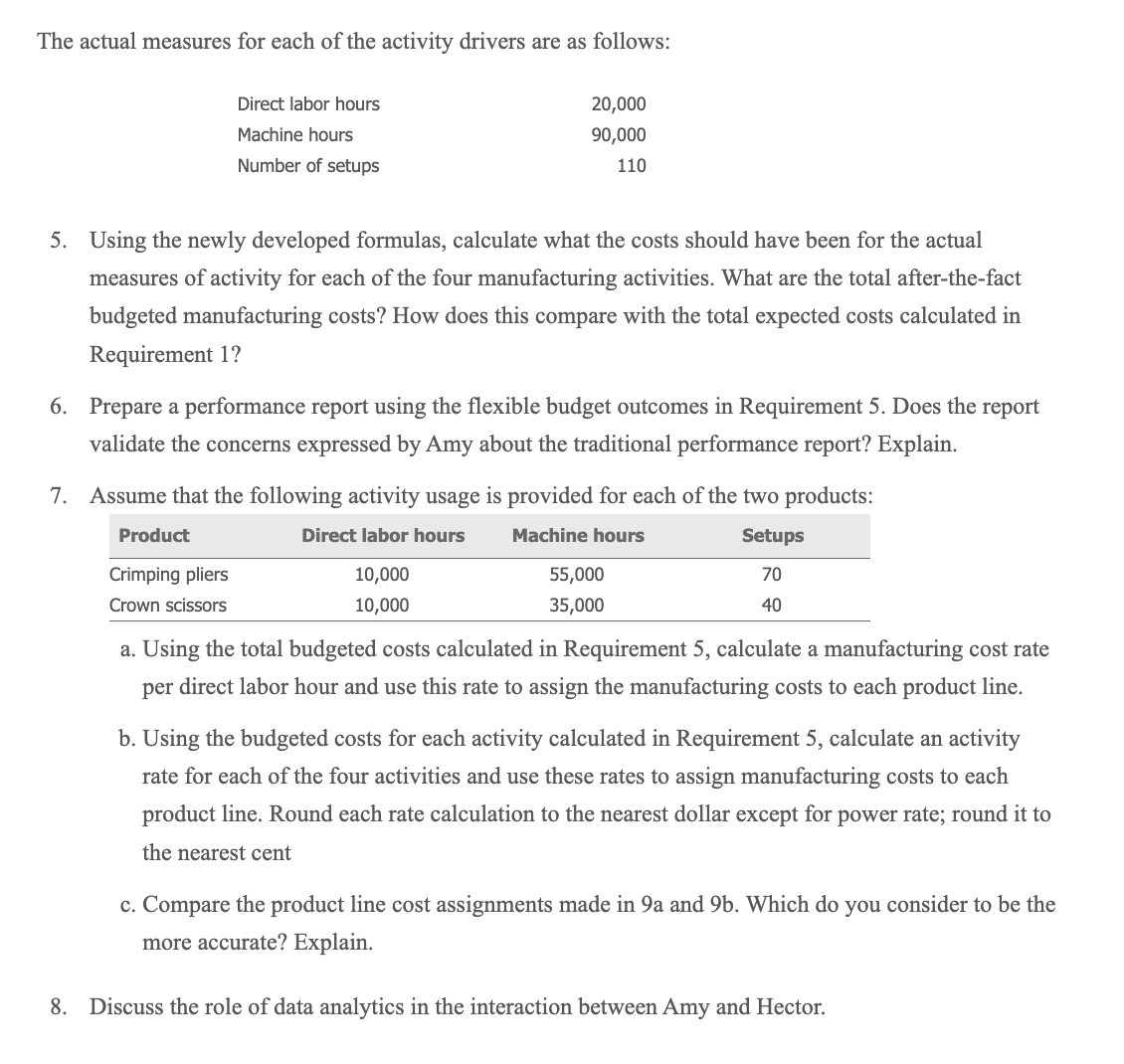Answered step by step
Verified Expert Solution
Question
1 Approved Answer
Please show ALL work Hector: First, we obtain formulas for the individual items in the budget by using the method of least squares. We assume




Please show ALL work
Hector: First, we obtain formulas for the individual items in the budget by using the method of least squares. We assume that cost variations can be explained by variations in production activity where activity is measured by direct labor hours. Here is a list of the cost formulas (flexible budget formulas) fo the four items you mentioned. The variable X is the number of direct labor hours. DirectmaterialscostDirectlaborcostPowercostSetupcost=$5X=$15X=$5,000+$4X=$100,000 Second, we predict what the costs should have been for the actual level of production activity for each item by using the actual direct labor hours. In your case, the actual direct labor hours used were 20,000 direct labor hours. Required: 1. Using the actual 20,000 direct labor hours, calculate what the costs should have been for each of the four manufacturing cost inputs. What are the total after-the-fact budgeted manufacturing costs? 2. Prepare a performance report using the flexible budget outcomes in Requirement 1 . Does the report confirm that Amy is overbudget by the amount initially claimed? 3. Suppose that Hector indicated that the standard wage rate is $15 but that because of overtime it actually averaged $16 for the period being considered. Hector also indicated that the direct labor hours allowed for the actual output were 20,500 hours. a. Calculate the labor rate and efficiency variances. b. Explain the most likely cause(s) of these two variances. 4. Refer to Exhibit 2.2. a. Which data analytic type or types best describe the calculation in Requirement 1 ? b. Consider Requirements 3a and 3b. Which data analytic type(s) best describe these two requirements? The actual measures for each of the activity drivers are as follows: 5. Using the newly developed formulas, calculate what the costs should have been for the actual measures of activity for each of the four manufacturing activities. What are the total after-the-fact budgeted manufacturing costs? How does this compare with the total expected costs calculated in Requirement 1 ? 6. Prepare a performance report using the flexible budget outcomes in Requirement 5. Does the report validate the concerns expressed by Amy about the traditional performance report? Explain. 7. Assume that the following activity usage is provided for each of the two products: a. Using the total budgeted costs calculated in Requirement 5, calculate a manufacturing cost rate per direct labor hour and use this rate to assign the manufacturing costs to each product line. b. Using the budgeted costs for each activity calculated in Requirement 5, calculate an activity rate for each of the four activities and use these rates to assign manufacturing costs to each product line. Round each rate calculation to the nearest dollar except for power rate; round it to the nearest cent c. Compare the product line cost assignments made in 9a and 9b. Which do you consider to be the more accurate? Explain. 8. Discuss the role of data analytics in the interaction between Amy and Hector. Budgeting, Variance Analysis, and Product Costing: Multiple Drivers Considered After considering the explanations and analyses offered by Hector, the interaction between the two continued as follows. Amy: I think I see the problem. Power costs don't have a lot to do with direct labor hours. They have more to do with machine hours. As production increases, machine hours increase more rapidly than direct labor hours. Also... Hector: You know, you have a point. The coefficient of determination for power cost is only about 50%. That leaves a lot of unexplained cost variation. The coefficient for the labor and materials equations, however, is much better. It explains about 96% of the cost variation in each case. Setup costs, of course, are fixed. Amy: Well, setup costs also have very little to do with direct labor hours. And they are certainly not fixed at least not all of them. We had to do more setups than our original plan called for because of the scheduling changes. And we must pay our people when they work extra hours. It seems like we are always paying overtime. I wonder if we simply do not have enough people for the setup activity. Also, there are supplies that are used for each setup and they are not cheap. Did you build these extra costs of increased setup activity into your budget? Hector: No, we assume that setup costs were fixed. I see now that some of them could vary as the number of setups increases. Amy, let me see if I can develop some flexible budgeting cost formulas based on better explanatory variables. I'll get back with you in a few days. After a few days' work, Hector developed the following flexible budget formulas, all with a coefficient of determination greater than 90% : Direct materials cost =$5X, where X= Direct labor hours Direct labor cost =$15X, where X= Direct labor hours Power cost =$68,000+0.9Y, where Y= Machine hours Setup cost =$98,000+$400Z, where Z= Number of setups Single Unit-Level Driver Lawson Dental Products produces two different dental instruments in its St. Louis plant: crown crimping pliers and curved crown scissors. Amy Bunker, production manager, was upset with the latest performance report which indicated that she was $110,000 over the manufacturing budget. Given the efforts that she and her workers had made, she was confident that they had met or beat the budget. Not only was she upset, but she was also genuinely puzzled by the results. Of the four major manufacturing inputs in the manufacturing cost budget (direct materials, direct labor, power, and setups), only the direct materials input was not over budget. The actual costs for these four inputs follow: Amy knew that her operation had produced more than originally had been planned so that more power and labor had naturally been used. She also knew that the uncertainty in scheduling had led to more setups than planned. When she pointed this out to Hector Gomez, the plant controller, he assured her that the budgeted costs had been adjusted for the increase in production activity. Curious, Amy asked about the methods to make the adjustment. Hector: If the actual level of production activity differs from the original planned level, we adjust the budget using what are called flexible budget formulas-formulas that allow us to predict cost for different levels of activity. Amy: The approach seems reasonable. However, I'm sure something is wrong here. Tell me exactly how you adjusted the costs of direct materials, direct labor, power, and setups. Hector: First, we obtain formulas for the individual items in the budget by using the method of least squares. We assume that cost variations can be explained by variations in production activity where activity is measured by direct labor hours. Here is a list of the cost formulas (flexible budget formulas) fo the four items you mentioned. The variable X is the number of direct labor hours. DirectmaterialscostDirectlaborcostPowercostSetupcost=$5X=$15X=$5,000+$4X=$100,000 Second, we predict what the costs should have been for the actual level of production activity for each item by using the actual direct labor hours. In your case, the actual direct labor hours used were 20,000 direct labor hours. Required: 1. Using the actual 20,000 direct labor hours, calculate what the costs should have been for each of the four manufacturing cost inputs. What are the total after-the-fact budgeted manufacturing costs? 2. Prepare a performance report using the flexible budget outcomes in Requirement 1 . Does the report confirm that Amy is overbudget by the amount initially claimed? 3. Suppose that Hector indicated that the standard wage rate is $15 but that because of overtime it actually averaged $16 for the period being considered. Hector also indicated that the direct labor hours allowed for the actual output were 20,500 hours. a. Calculate the labor rate and efficiency variances. b. Explain the most likely cause(s) of these two variances. 4. Refer to Exhibit 2.2. a. Which data analytic type or types best describe the calculation in Requirement 1 ? b. Consider Requirements 3a and 3b. Which data analytic type(s) best describe these two requirements? The actual measures for each of the activity drivers are as follows: 5. Using the newly developed formulas, calculate what the costs should have been for the actual measures of activity for each of the four manufacturing activities. What are the total after-the-fact budgeted manufacturing costs? How does this compare with the total expected costs calculated in Requirement 1 ? 6. Prepare a performance report using the flexible budget outcomes in Requirement 5. Does the report validate the concerns expressed by Amy about the traditional performance report? Explain. 7. Assume that the following activity usage is provided for each of the two products: a. Using the total budgeted costs calculated in Requirement 5, calculate a manufacturing cost rate per direct labor hour and use this rate to assign the manufacturing costs to each product line. b. Using the budgeted costs for each activity calculated in Requirement 5, calculate an activity rate for each of the four activities and use these rates to assign manufacturing costs to each product line. Round each rate calculation to the nearest dollar except for power rate; round it to the nearest cent c. Compare the product line cost assignments made in 9a and 9b. Which do you consider to be the more accurate? Explain. 8. Discuss the role of data analytics in the interaction between Amy and Hector. Budgeting, Variance Analysis, and Product Costing: Multiple Drivers Considered After considering the explanations and analyses offered by Hector, the interaction between the two continued as follows. Amy: I think I see the problem. Power costs don't have a lot to do with direct labor hours. They have more to do with machine hours. As production increases, machine hours increase more rapidly than direct labor hours. Also... Hector: You know, you have a point. The coefficient of determination for power cost is only about 50%. That leaves a lot of unexplained cost variation. The coefficient for the labor and materials equations, however, is much better. It explains about 96% of the cost variation in each case. Setup costs, of course, are fixed. Amy: Well, setup costs also have very little to do with direct labor hours. And they are certainly not fixed at least not all of them. We had to do more setups than our original plan called for because of the scheduling changes. And we must pay our people when they work extra hours. It seems like we are always paying overtime. I wonder if we simply do not have enough people for the setup activity. Also, there are supplies that are used for each setup and they are not cheap. Did you build these extra costs of increased setup activity into your budget? Hector: No, we assume that setup costs were fixed. I see now that some of them could vary as the number of setups increases. Amy, let me see if I can develop some flexible budgeting cost formulas based on better explanatory variables. I'll get back with you in a few days. After a few days' work, Hector developed the following flexible budget formulas, all with a coefficient of determination greater than 90% : Direct materials cost =$5X, where X= Direct labor hours Direct labor cost =$15X, where X= Direct labor hours Power cost =$68,000+0.9Y, where Y= Machine hours Setup cost =$98,000+$400Z, where Z= Number of setups Single Unit-Level Driver Lawson Dental Products produces two different dental instruments in its St. Louis plant: crown crimping pliers and curved crown scissors. Amy Bunker, production manager, was upset with the latest performance report which indicated that she was $110,000 over the manufacturing budget. Given the efforts that she and her workers had made, she was confident that they had met or beat the budget. Not only was she upset, but she was also genuinely puzzled by the results. Of the four major manufacturing inputs in the manufacturing cost budget (direct materials, direct labor, power, and setups), only the direct materials input was not over budget. The actual costs for these four inputs follow: Amy knew that her operation had produced more than originally had been planned so that more power and labor had naturally been used. She also knew that the uncertainty in scheduling had led to more setups than planned. When she pointed this out to Hector Gomez, the plant controller, he assured her that the budgeted costs had been adjusted for the increase in production activity. Curious, Amy asked about the methods to make the adjustment. Hector: If the actual level of production activity differs from the original planned level, we adjust the budget using what are called flexible budget formulas-formulas that allow us to predict cost for different levels of activity. Amy: The approach seems reasonable. However, I'm sure something is wrong here. Tell me exactly how you adjusted the costs of direct materials, direct labor, power, and setupsStep by Step Solution
There are 3 Steps involved in it
Step: 1

Get Instant Access to Expert-Tailored Solutions
See step-by-step solutions with expert insights and AI powered tools for academic success
Step: 2

Step: 3

Ace Your Homework with AI
Get the answers you need in no time with our AI-driven, step-by-step assistance
Get Started


